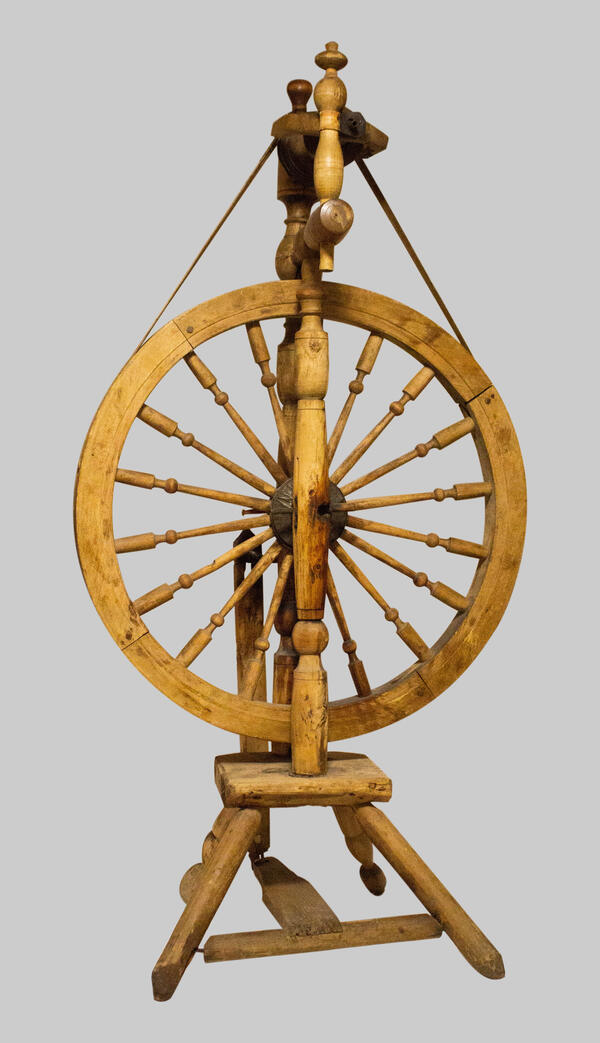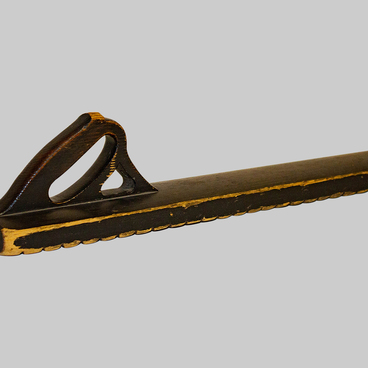It is believed that the self-spinning wheel first appeared in India, from where it came to Europe and spread across the continent by the early 14th century. In Russia, there were two types of spinning wheels: a stand, or a Russian, and a lounger, or a chukhonka. The difference was in the position of the wheel: on Russian spinning wheels, it was placed perpendicular to the floor, on chukhonkas, at an angle. The presented spinning wheel belongs to the first type.
The spinner began work by spinning a small piece of thread, approximately the length of an arm. Then this piece was wound around the spindle shaft. Then the spinner accelerated the wheel with one hand, while continuing to form the thread with the other. By the 15th century, an improvement appeared at the front end of the spindle — the ‘flyer.’
The spinner began work by spinning a small piece of thread, approximately the length of an arm. Then this piece was wound around the spindle shaft. Then the spinner accelerated the wheel with one hand, while continuing to form the thread with the other. By the 15th century, an improvement appeared at the front end of the spindle — the ‘flyer.’
This device allowed the thread to be wound onto a special spool. Both ends of the ‘flyer’ served as a reel, while the spindle was its axis. So preparatory straightening of the thread by hand was no longer required. The original combed tow (roving) passed through the hole in the tip of the spindle, then through the hook of the flyer, after which the tow went to the reel. The reel and flyer were connected to the drive wheel by two separate belts, each with its own. The flyer rotated slightly faster than the coil, due to the difference in the size of the pulleys — wheels that transmit motion to the drive belt. From now on, spinning could not be interrupted for twisting and winding. Rotating, the flyer itself twisted the tow into a thread before it lay on the reel, therefore such a device was popularly called a self-spinning wheel.
A century later, a mechanical foot drive was added to the self-spinning wheel, which accelerated the process of thread making. In the 15th century, Leonardo da Vinci invented a large multi-spindle machine with hand-operated winding machines, which made it possible to spin thread on an industrial scale. However, the fate of this invention is currently unknown. In Russia, the multi-spindle spinning and combing machine was invented and built in 1760 by the Russian merchant-entrepreneur Rodion Glinkov. The mechanism was driven by a water millwheel, serviced by two workers and increased labor productivity fivefold. With the advent of electricity, spinning wheels were also made on electric traction. In the Soviet Union, electric spinning wheels were produced until the end of the 20th century.
A century later, a mechanical foot drive was added to the self-spinning wheel, which accelerated the process of thread making. In the 15th century, Leonardo da Vinci invented a large multi-spindle machine with hand-operated winding machines, which made it possible to spin thread on an industrial scale. However, the fate of this invention is currently unknown. In Russia, the multi-spindle spinning and combing machine was invented and built in 1760 by the Russian merchant-entrepreneur Rodion Glinkov. The mechanism was driven by a water millwheel, serviced by two workers and increased labor productivity fivefold. With the advent of electricity, spinning wheels were also made on electric traction. In the Soviet Union, electric spinning wheels were produced until the end of the 20th century.



